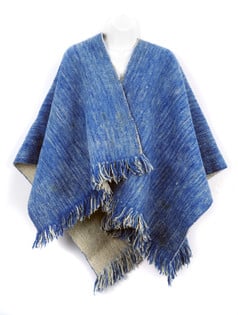Presented by Museum of the Peace Corps Experience and American University Museum
Andes Mountains, c. 1962
Lenguazaque, Cundinamarca, Colombia
Wool, 32 x 42 in.
Collection, Museum of the Peace Corps Experience
Gift of Kay Dixon, Colombia, Medellin 1962–64

Ron Atwater, a Colombia One volunteer, organized a ruana cooperative at his post in Lenguazaque in the Departmento de Cundinamarca in the Andes Mountains. These ruanas of 100-percent virgin wool were perfect for the Andean climate.
The process began with raising sheep for their wool. The sheep were sheared and their wool spun into yarn. Then workers dyed the yarn with natural dyes. Finally artisans wove the yarn into a ruana using a special loom. A totally manual process! At that time, the best craftsmen could complete about five ruanas daily. The final products in an adult size weighed about five pounds and were sold in open markets in Medellin.
Ruanas from this co-op were sold at the Hotel Tequendama, Bogota’s premier four-star hotel. I placed an order, with crossed fingers, and was thrilled when my order was fulfilled. It became the ultimate keepsake from my time as a PCV. It was perfect for my Antioquia lifestyle: a shawl for cool days or chilly nights, a blanket for my bed, a pillow, a picnic blanket, a seat cover when riding in a chiva (open-sided bus). Easily stored by tossing it over the single Adirondack chair in my apartment, it’s also a room decoration. The one-size-fits-all feature is not to be underestimated!
During the 1960s ruanas were exported and sold at Saks Fifth Avenue in New York City for premium prices. Today ruanas in multiple fabrics and colors are worn all over the Western world. The word “ruana” is now part of the fashion lexicon.
The Colombian people have survived many years of civil war and violence. The ruana reminds me of their persistence, courage, and tenacity in their struggle for progress and development.
Museum of the Peace Corps Experience
PO Box 2427
Oregon City, OR 97045
USA
The Committee for a Museum of the Peace Corps Experience is a 501(c)(3) private nonprofit organization. Tax ID: EIN # 93-1289853
The Museum is not affiliated with the U.S. Peace Corps and not acting on behalf of the U.S. Peace Corps.
Museum of the Peace Corps Experience © 2024. All Rights Reserved.